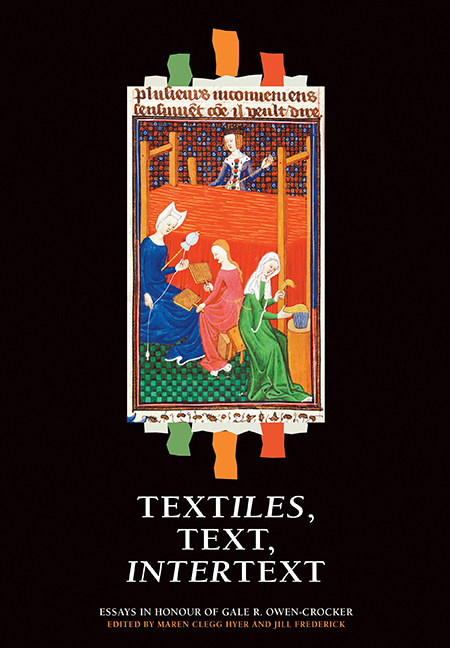Book contents
- Frontmatter
- Contents
- List of Illustrations
- List of Abbreviations
- Introduction
- A Personal Recollection
- List of publications of Gale R. Owen Crocker
- Part I Textile
- Part II Text
- Part III Intertext
- 10 Weaving Words on the Ruthwell Cross
- 11 Fates of the Apostles and Tituli
- 12 Weaving and Interweaving: The Textual Traditions of Two of Ælfric's Supplementary Homilies
- 13 Invisible Things in London, British Library, Cotton Vitellius A. xv
- 14 Redacting Harold Godwinson: The Vita Haroldi and William of Malmesbury
- Index
- Tabula Gratulatoria
10 - Weaving Words on the Ruthwell Cross
from Part III - Intertext
Published online by Cambridge University Press: 05 July 2016
- Frontmatter
- Contents
- List of Illustrations
- List of Abbreviations
- Introduction
- A Personal Recollection
- List of publications of Gale R. Owen Crocker
- Part I Textile
- Part II Text
- Part III Intertext
- 10 Weaving Words on the Ruthwell Cross
- 11 Fates of the Apostles and Tituli
- 12 Weaving and Interweaving: The Textual Traditions of Two of Ælfric's Supplementary Homilies
- 13 Invisible Things in London, British Library, Cotton Vitellius A. xv
- 14 Redacting Harold Godwinson: The Vita Haroldi and William of Malmesbury
- Index
- Tabula Gratulatoria
Summary
One meaning of the Latin word textus is “woven”, deriving from the verb for “to weave”. In her work on memory and memoria, Mary Carruthers has demonstrated the ways in which texts (by which she means written Latin texts) “become institutions as they weave a community together by providing it with shared experiences and a certain kind of language, the language of stories that can be experienced over and over again through time and as occasion suggests”. We still speak, for example, of weaving a web of words, or of unravelling the meaning of a riddle, both acts that continue to bind together communities of literate writers and readers. But more recently, Tim Ingold has revisited this sense of “to weave”, using it in its more familiar definition of a physical craft involving cloth, but extending it as a metaphor for craft and for human life in general. Our lives are woven together from a network of different threads of experiences, such as walking the land, or our encounters with our fellow human beings, with animals, and with objects as we move continuously forward overlapping with them through time and space. In this essay in honour of Gale R. Owen-Crocker, I use the metaphor of weaving as a way of both encountering and understanding the eighth-century Ruthwell Cross, a monument that binds together multiple images, languages and literary styles, and which can be understood in multiple ways beyond the usual stylistic, iconographic, or liturgical analyses.
It is most likely that the Ruthwell Cross was originally erected out of doors, possibly near the western end of a now-lost church, or possibly near the shore of the Solway Firth. We now have no way of being certain where it stood in the eighth century, although some of the earliest legends of the cross that survive speak of its having been moved inside a church after having been found near the shore. Wherever it was first erected, it was definitely located inside Murray's Quire, a funerary chapel that abutted the south wall of the nave, at the time of the Reformation, when it was pulled down and partially buried in the floor of the quire. Originally it would have stood nearly eighteen feet high, an imposing vertical line in a relatively flat landscape.
- Type
- Chapter
- Information
- Textiles, Text, IntertextEssays in Honour of Gale R. Owen-Crocker, pp. 183 - 198Publisher: Boydell & BrewerPrint publication year: 2016



